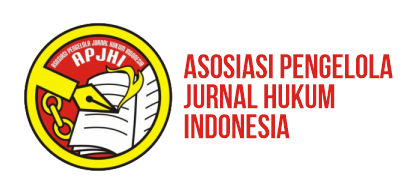Membedah Doktrin Kerugian Konstitusional
DOI:
https://doi.org/10.31078/jk1412Keywords:
Kerugian Konstitusional, Kedudukan Hukum Pemohon, Pengujian Undang-Undang, Mahkamah Konstitusi, Constitutional Injury, Legal Standing, Judicial Review, the Constitutional CourtAbstract
Penetapan ukuran kerugian konstitusional memiliki kedudukan strategis sebagai pintu gerbang atas pengujian norma yang hendak diuji. Mahkamah Konstitusi merumuskan syarat kerugian konstitusional berdasarkan penafsiran Pasal 51 ayat (1) Undang-Undang Mahkamah Konstitusi. Doktrin kerugian konstitusional terdiri dari lima syarat yang dapat diklasifikasikan dalam dua kelompok. Kelompok pertama berisikan unsur-unsur yang harus dipenuhi pemohon terdiri dari (i) adanya hak dan/atau kewenangan konstitusional dan (ii) ada kerugian. Kelompok kedua merupakan prosedur pengujian mengenai ukuran kerugian yang diderita pemohon yang didalamnya yang terdiri dari (i) bentuk kerugian, (ii) hubungan kausalitas dan (iii) pemulihan kerugian. Kelima syarat ini bersifat kumulatif. Dalam penerapannya, doktrin kerugian konstitusional ini sangatlah dinamis. Ada kecenderungan bahwa doktrin ini menyimpan permasalahan. Tulisan ini berupaya mengidentifikasi masalah yang ada dalam penerapan doktrin kerugian konstitusional. Salah satunya adalah tumpang tindihnya antara pembuktian hak konstitusional pemohon dalam bagian kedudukan hukum dengan pengujian norma dalam pokok perkara. Sedangkan konkretisasi pembuktian unsur kerugian berkelindan dengan pengujiannya dalam kelompok doktrin kedua. Oleh karenanya, tulisan ini berkesimpulan bahwa telah ada kebutuhan untuk melakukan penyempurnaan doktrin kerugian konstitusional dengan melakukan penafsiran ulang atas Pasal 51 ayat (1) Undang-Undang Mahkamah Konstitusi dan tidak lagi mencantumkan kelompok pertama dalam doktrin kerugian konstitusional untuk pemeriksaan pengujian Undang-Undang di masa yang akan datang.The concept of constitutional injury is a substantial pre-requisite in the examination of judicial review case. The Constitutional Court drafted the concept as an interpretation of Article 51(1) of the Law on the Constitutional Court. It consists of five conditions that can be classified into two groups. The first group contains elements that must be met by the applicant which are (i) constitutional rights and/or authorities and (ii) injuries. The second group is the test in regard to the size of the injury suffered by the applicant therein consisting of (i) forms of injury, (ii) causality and (iii) redressability. The requirement is accumulative. Yet in practice the doctrine is variedly applied. There is tendency the doctrine itself causes problems. This paper seeks to identify the problems and aimed to give solution to the problem. Two problems are identified, one is an overlap examination of constitutional rights in standing and also in ratio decidendi. Another one is that the injury element in the doctrine intertwined with its own testing in the second group of the doctrine. Therefore, this paper concludes that there is a need to revise the doctrine with reinterpretation of Article 51 (1) of the Law and recommend not to exclude the first group of the doctrine.
References
I Dewa Gede Palguna, 2013, Pengaduan Konstitusional: Upaya Hukum terhadap Pelanggaran Hak-Hak Konstitusional Warga Negara, Jakarta: Sinar Grafika.
Jimly Asshiddiqie, 2006, Perkembangan dan Konsulidasi Lembaga Negara Pasca Reformasi, Jakarta: Konstitusi Press.
Ken Cooper Stephenson, 2013, Constitutional Damage Worldwide, Carswell.
Simon Butt, 2015, The Constitutional Court and Democracy in Indonesia, Leiden: Brill Nijhoff.
Artikel
Bisariyadi, 2016, "Atypical Rulings of The Indonesian Constitutional Court", Hasanuddin Law Review, Vol. 2, Issue 2, August, h. 225-240.
Brandon L. Garrett, 2014, "The Constitutional Standing of Corporations", University of Pennsylvania Law Review, Vol. 163. h. 96-163
Bronwyn Le-Ann Batchelor, 2011, Constitutional Damages For The Infringement Of A Social Assistance Right In South Africa: Are Monetary Damages In The Form Of Interest A Just And Equitable Remedy For Breach Of A Social Assistance Right?, Tesis untuk Master of Laws di Nelson Mandela School of Law, University of Fort Hare.
Evan Tsen Lee dan Josephine Mason Ellis, 2012, "The Standing Doctrine’s Little Secret", Northwestern University Law Review, Vol. 107, No. 1.
Gene R. Nichol Jr., 1980, "Causation as a Standing Requirement: The Unprincipled Use of Judicial Restraint" Kentucky Law Journal, vol. 69, h.185.
Hamdan Zoelva, 2010, "Tinjauan Konstitusional Penataan Lembaga Non-Struktural di Indonesia", Jurnal Negarawan, Sekretariat Negara RI, November.
Harold J. Krent, 2001, "Laidlaw: Redressing the Law of Redressability", Duke Environmental Law and Policy Forum, Vol. 12.
Jennifer B. Wriggins, 2010, "Constitution Day Lecture: Constitutional Law and Tort Law: Injury, Race, Gender and Equal Protection", Maine Law Review, Vol. 63, No. 1, h. 264-275
Robert Dugan, 1971, "Standing to Sue: A Commentary on Injury in Fact", Case Western Reserve Law Review, Vol. 22, No. 2.
William A. Fletcher, 1988, "The Structure of Standing", Yale Law Journal, Vol.98, No. 1, h.221- 290.
Internet
Laica Marzuki, "Legal Standing", Sisi Lain Pengujian UU di MK, Harian Kompas, sebagaimana diperoleh dari http://www.kompas.co.id/kompascetak/0411/08/opini/1369103.htm diakses pada 27 Desember 2016
Mahardika Satria Hadi, 2015, "Jihad Konstitusi", Jihad Baru Muhammadiyah, Tempo.co, Rabu, 22 Juli, https://m.tempo.co/read/news/2015/07/22/078685566/feature-jihad-konstitusi-jihad-baru-muhammadiyah, diakses pada 27 Desember 2016.
Downloads
Published
How to Cite
Issue
Section
License
Authors who publish with this journal agree to the following terms:
- Copyright of the published articles will be transferred to the journal as the publisher of the manuscripts. Therefore, the author confirms that the copyright has been managed by the publisher.
- The publisher of Jurnal Konstitusi is The Registrar and Secretariat General of the Constitutional Court of the Republic of Indonesia.
- The copyright follows Creative Commons Attribution-NonCommercial-ShareAlike 4.0 International License: This license allows reusers to distribute, remix, adapt, and build upon the material in any medium or format for noncommercial purposes only, and only so long as attribution is given to the creator. If you remix, adapt, or build upon the material, you must license the modified material under identical terms.

















